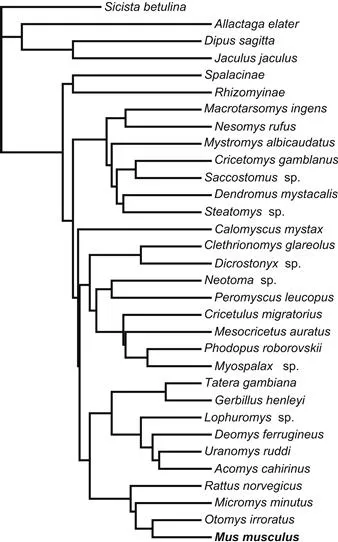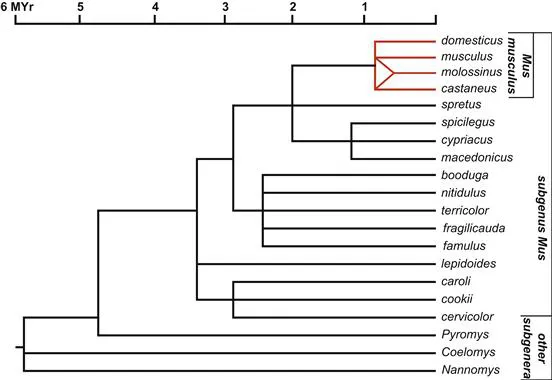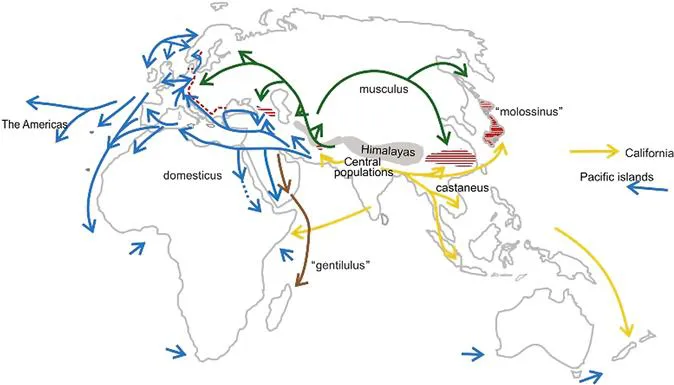
eBook - ePub
The Laboratory Mouse
Hans Hedrich, Hans Hedrich
This is a test
Buch teilen
- 868 Seiten
- English
- ePUB (handyfreundlich)
- Über iOS und Android verfügbar
eBook - ePub
The Laboratory Mouse
Hans Hedrich, Hans Hedrich
Angaben zum Buch
Buchvorschau
Inhaltsverzeichnis
Quellenangaben
Über dieses Buch
The Laboratory Mouse, Second Edition is a comprehensive book written by international experts. With inclusions of the newly revised European standards on laboratory animals, this will be the most current, global authority on the care of mice in laboratory research. This well-illustrated edition offers new and updated chapters including immunology, viruses and parasites, behavior, enrichment and care standards of laboratory mice across the life sciences, medical and veterinary fields.
- Features four-color illustrations with complete instruction on mouse surgery, anatomy, behavior and care of the mouse in laboratory research
- Offers additional chapters on new mouse strains, phenotyping of strains, bacteria and parasites, and immunology
- Includes the newly revised EU standards on care, as well as, comparisons to standards and regulations in the US and other countries
Häufig gestellte Fragen
Wie kann ich mein Abo kündigen?
Gehe einfach zum Kontobereich in den Einstellungen und klicke auf „Abo kündigen“ – ganz einfach. Nachdem du gekündigt hast, bleibt deine Mitgliedschaft für den verbleibenden Abozeitraum, den du bereits bezahlt hast, aktiv. Mehr Informationen hier.
(Wie) Kann ich Bücher herunterladen?
Derzeit stehen all unsere auf Mobilgeräte reagierenden ePub-Bücher zum Download über die App zur Verfügung. Die meisten unserer PDFs stehen ebenfalls zum Download bereit; wir arbeiten daran, auch die übrigen PDFs zum Download anzubieten, bei denen dies aktuell noch nicht möglich ist. Weitere Informationen hier.
Welcher Unterschied besteht bei den Preisen zwischen den Aboplänen?
Mit beiden Aboplänen erhältst du vollen Zugang zur Bibliothek und allen Funktionen von Perlego. Die einzigen Unterschiede bestehen im Preis und dem Abozeitraum: Mit dem Jahresabo sparst du auf 12 Monate gerechnet im Vergleich zum Monatsabo rund 30 %.
Was ist Perlego?
Wir sind ein Online-Abodienst für Lehrbücher, bei dem du für weniger als den Preis eines einzelnen Buches pro Monat Zugang zu einer ganzen Online-Bibliothek erhältst. Mit über 1 Million Büchern zu über 1.000 verschiedenen Themen haben wir bestimmt alles, was du brauchst! Weitere Informationen hier.
Unterstützt Perlego Text-zu-Sprache?
Achte auf das Symbol zum Vorlesen in deinem nächsten Buch, um zu sehen, ob du es dir auch anhören kannst. Bei diesem Tool wird dir Text laut vorgelesen, wobei der Text beim Vorlesen auch grafisch hervorgehoben wird. Du kannst das Vorlesen jederzeit anhalten, beschleunigen und verlangsamen. Weitere Informationen hier.
Ist The Laboratory Mouse als Online-PDF/ePub verfügbar?
Ja, du hast Zugang zu The Laboratory Mouse von Hans Hedrich, Hans Hedrich im PDF- und/oder ePub-Format sowie zu anderen beliebten Büchern aus Biological Sciences & Physiology. Aus unserem Katalog stehen dir über 1 Million Bücher zur Verfügung.
Information
Part 1
History and Genetics
Chapter 1.1 Origins and Phylogenetic Relationships of the Laboratory Mouse
Chapter 1.2 Historical Foundations
Chapter 1.3 Strains, Stocks and Mutant Mice
Chapter 1.4 Mouse Genomics
Chapter 1.5 Generation of Mouse Mutants by Genotype-Driven Mutagenesis
Chapter 1.1
Origins and Phylogenetic Relationships of the Laboratory Mouse
Institut Pasteur, Paris, France
Université de Montpellier 2, France
Introduction
On the basis of zooarcheological data it has been established that humans and mice were already in close contact at the end of the last glacial period, at the time of the Neolithic revolution, i.e. about 12 000 years ago [1–3]. Archaeological records have confirmed that by the Bronze Age (3000 years BC) house mice were quasi-obligatory commensals of established farming communities, and as a consequence they were transported almost everywhere the maritime trade could carry them at that time, i.e. essentially around the Mediterranean [1, 3–5]. A further step was taken with the grand circumnavigations of the last five centuries, which transported mice almost everywhere around the world. Finally, historical records indicate that mice were bred as pet animals as early as three millennia ago in several parts of the world, particularly Japan and China [1, 3–5]. It was thus totally logical that this small mammal, like the rat and some small birds, should be used by early scientists for performing their experiments. Even if this choice was opportunistic rather than being based on purely scientific considerations, it nonetheless appears nowadays to be an excellent one in the context of modern biomedical research where the house mouse has become a preferred model.
Mice are easy to breed. Because they are rodents, they eat rather large quantities of food for their size but do not have very specific or costly nutritional requirements. Under favourable conditions they breed all year round, with a short generation time. They give rise to relatively large progenies and tolerate inbreeding rather well compared to other mammalian species.
Over the years hundreds of mutations—most of them resulting in alleles with deleterious effects—have been collected and most, not to say all, of these mutations have contributed and still contribute to a better understanding of gene function(s). Because these mutant mice often represent animal models of human genetic diseases, several programs of intensive mutagenesis making use of the powerful mutagen ethylnitrosourea (ENU) have been developed worldwide to increase further this invaluable resource [6, 7].
Finally, two other very important advantages must be credited to the mouse as a model organism. (i) In this species, it is possible to grow in vitro, for several generations, totipotent embryonic stem (ES) cells that can be genetically modified in a number of ways but retain their capacity to participate in the formation of a germ line once inserted into the blastocystic cavity of a developing embryo [8, 9]. (ii) Importantly, the complete sequence of the mouse genome is now available on line, with a high-quality annotation, allowing comparisons with other mammalian genomes, including rat and human, to be performed with great accuracy [10]. In short, the mouse is one of the very few mammalian species to date whose genomic sequence has been entirely determined and for which technical procedures are available for the generation of a virtually unlimited number of genetic alterations, some of which are conditional, i.e. expressed only when the experimenter wishes.
In this chapter we describe the origins of laboratory mice, starting with their phylogenetic relationships with other mammalian species. We also discuss the advantage of strains established from recently trapped wild specimens as a source of polymorphisms for scientific research.
Phylogenetic relationships of the house mouse
The position of rodents among mammalian species
Mice are rodents. They belong to the most abundant (around 40%) and diversified order of living placental mammals, with some 2277 species grouped in 33 families [11]. Because of a relative homogeneity in their external appearance, the phylogenetic relationships between the different species of this order have sometimes been a matter of controversy, especially when morphological characters (tail, body shape, coat colour, etc.) were the only criteria available for the establishment of these relationships. Nowadays, with the use of various molecular markers (mostly DNA) and possible references to the complete genomic sequence of numerous orthologous genes, the situation has been much clarified. Figure 1.1.1, which is based on comparisons at the level of nuclear DNA sequences, represents the most likely phylogenetic tree for a sample of 28 different vertebrate species including the murid rodents (Mus and Rattus genera). The divergence between humans and mice of the Mus genus occurred somewhere between 70 and 75 Myr ago [10].

Figure 1.1.1 Tree indicating evolutionary relationships among 28 vertebrate species. Branch lengths are proportional to the number of base pair substitutions at a certain number of specific sites. The estimated time of divergence between human, and rodents was set approximately 75 Myr ago.
Redrawn from Miller W. et al., Genome Res. 17, 1797–1808, 2007.
The position of mice among rodents
The rodent family Muridae encompasses at least 1326 species grouped in 281 genera [11]. The establishment of the evolutionary systematics in this group has also been controversial because of similarities in size and shape of the different species. Here again, studies making use of DNA sequences of various types have greatly contributed to clarify the situation [11–15]. Figure 1.1.2 represents the evolutionary relationships among a sample of 32 species of rodents including the mouse (Mus musculus) and rat (Rattus norvegicus). The divergence between the Mus and Rattus genera probably occurred around 10–12 Myr ago [14, 15], while the divergence of these two genera from Peromyscus maniculatus, the deer mouse (subfamily Sigmodontinae), occurred around 25 Myr ago. This should be kept in mind because deer mice, which are abundantly used as laboratory models in the USA, are often as considered close relatives of the laboratory mice of the genus Mus while, in fact, they are no more related to them than hamsters are.

Figure 1.1.2 Phylogenetic relationships among 32 species of rodents representing 14 subfamilies of Muridae.
Redrawn from Michaux et al., Mol. Biol. Evol. 18, 2017–2031, 2001.
Systematics in the genus Mus
The genus Mus contains four subgenera: Mus, Coelomys, Pyromys and Nannomys, totalling 41 species at present [16]. The individualization of the subgenus Mus sensu stricto occurred around 6.5 Myr ago with the split from three other different subgenera [17].
Members of this genus can be distinguished from other genera belonging to the same murine subfamily by a series of morphological characters [18, 19]. An accurate and up-to-date description of the genus with its different species and their geographical distribution is provided in Auffray and Britton-Davidian [16]. Briefly, the original geographic distribution of the genus Mus encompasses most of Eurasia and Africa, while its presence elsewhere results from human-mediated introductions during recent millennia. The highest taxonomic diversity occurs in Asia (with 3 subgenera and 19 species) where this genus likely originated [18–21].
Considering the high number of taxa that have been described recently and thanks to the use of molecular markers, it is reasonable to think that the number of species in the subgenus Mus may still increase further. South East Asia, which has provided four of the five new species recently characterized, appears to be the key geographic area where new species may be found. In this context the case of Mus cypriacus, described in Cyprus, is noteworthy [22]. New species are even more likely to be discovered if we consider that the habitat of some of these new species is extremely limited and sometimes embedded in the wider habitat of another species [22, 23]. The subgenus Nannomys, which thrives in Africa, is also very likely to give rise to many new taxa as its systematics is studied more carefully [24].
Figure 1.1.3 summarizes the phylogenetic relationships within the genus Mus (subfamily Murinae). The subgenus Mus contains several species that are extremely similar in size and shape but seldom hybridize in the wild. Among the Asian species are Mus cervicolor, Mus cookii and Mus caroli, which form a group. The Indian pigmy mice related to Mus terricolor (formerly Mus dunni) together with Mus famulus from India as well as the more recently discovered species Mus fragilicauda[23] from Thailand and Mus nitidulus from Laos [25] should also be cited as forming a second group. The third group is that of Mus musculus and the other Palearctic species. Within this group, Mus spicilegus and Mus macedonicus are short-tailed mice that are found from the Caucasus to central Europe and the eastern Mediterranean, respectively, while mice belonging to the species Mus spretus are common in the western Mediterranean regions (south-eastern France, Spain, Portugal and North Africa). Finally, the recently rediscovered species Mus lepidoides from Burma [26] forms a fourth group of its own. For a more accurate description of the phylogeny within the subgenus see Suzuki and colleagues [20, 21].

Figure 1.1.3 Consensus phylogenetic tree of the genus Mus issued from a compilation of all extant studies (see text). The approximate time scale (in Myr) stems from the recent calibration of Lecompte et al. [17].
Within the subgenus Mus there is a set of closely related subspecies of special interest to us because they constitute the house mouse (M. musculus) complex. These subspecies have their evolutionary origins in the Indian subcontinent and surrounding regions [27, 28]. The best-known representatives are those from the periphery of the original range that have been transported to the five continents since they became human commensals during the Neolithic: Mus m. domesticus, common in western Europe, Africa and the Near East and transported by humans to the Americas and Australia (Figure 1.1.4); Mus m. musculus, whose habitat ranges from eastern Europe to Japan, across Russia, and northern China; and Mus m. castaneus, which is found from Sri Lanka to South East Asia including the Indo-Malayan archipelago. Various molecular criteria discriminate easily between these different species at the periphery of the species range [5, 29]. It is, however, more difficult to understand what exactly happened in the centre of the range, where a mixture of primary differentiation and secondary intergradation seems to be the rule, especially in the highly mountainous and fragmented areas between Iran and northern India [30]. This is why a certain number of relatively infrequently used Latin trinomens (e.g. M. m. bactrianus, M. m. homourus, M. m. urbanus) are described from this region, although it is currently impossible to disentangle real differentiation from artificial synonymy (Figure 1.1.5).

Figure 1.1.4 Summary of the inferred colonization history of the house mouse (M. musculus). The history starts with an origin, and differentiation in the vicinity of the Indian subcontinent, and with arrows indicating the colonizing mo...